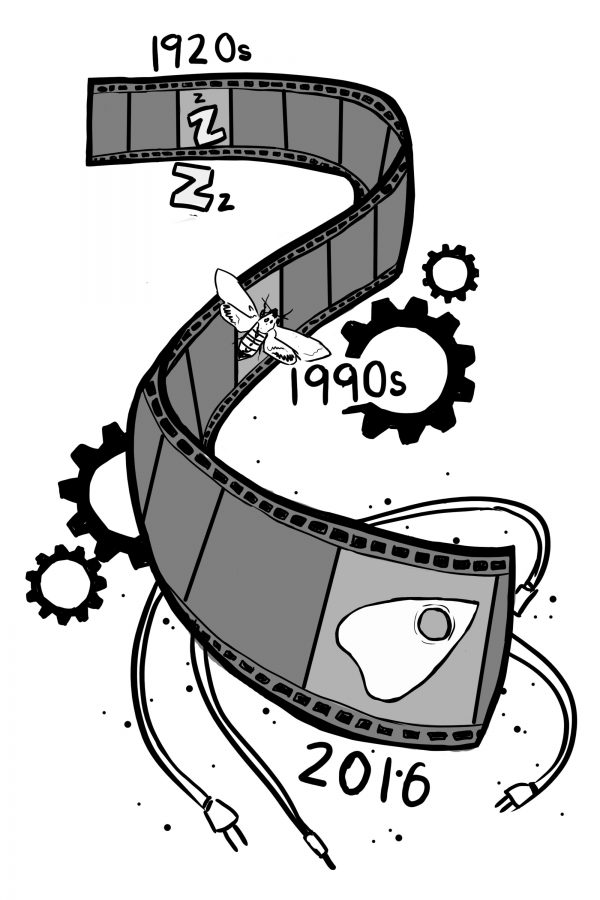When filmmakers let technology become more than a tool
The earliest movies were grainy, black and white and under a minute long. As film became less of a novelty and evolved into a full-scale industry, movies began to incorporate the usage of more advanced technologies such as rotating cameras, special effects, animation, color and sound. Horror as a genre began with short black and white movies that introduced supernatural elements but were not ultimately intended to be scary. However, as the genre progressed, an increasing attempt was made to unsettle audiences with the help of new technologies. The increased use of technology to create special effects has spurred the evolution of the horror genre into the jump scare and gore-ridden movies we see today.
The early 1900s saw the production of some of the most famous horror movies to this date, including “Dracula,” “Nosferatu,” “Frankenstein” and “The Hunchback of Notre Dame.” These movies, many of them silent and in black and white, are still considered iconic today despite their lack of modern technology.
“The Cabinet of Dr. Caligari” is an example of a movie during this time period that worked within the limitations of early technology to create an effective horror movie. Produced in the 1920s, the movie featured the story of a German doctor who uses a somnambulist to commit a series of murders. The film, while not scary by modern standards, communicates a complicated plot through the use of practical effects such as handpainted sets and costume make-up. Still, due to the movie’s inability to utilize sound and realistic scenery, it fails to assert a strong emotional pull on viewers’ emotions.
Since “Dr. Caligari,” larger budgets and the development of special effects, along with improved camera technology and editing software in the 1980s and 1990s, have allowed movies to use technology to enhance their storylines.
Jonathan Demme’s 1991 film “The Silence of the Lambs” effectively uses special effects to strengthen its plot without overwhelming the audience. The character-dependent and plot-driven movie features a young detective on the hunt for an elusive serial killer. The movie follows young FBI student Clarice Starling, who must use her fragile relationship with brilliant psychopath Dr. Hannibal Lecter in order to obtain information to find an elusive serial killer. Special effects are utilized, but they seem to add to the plot and enhance the movie rather than serve to simply scare the audience. “Silence of the Lambs” seems more like a psychological thriller and less like the typical horror movies that are marketed today, which often feature supernatural elements and are riddled with jump scares and gory images.
Through more recent developments in film technology such as computer-generated imagery and post-production editing, filmmakers are able to make virtually any scenario to come to life. The availability of such technology seems to have had a large impact on the horror genre, as many recent movies seem to have become less plot-driven and more about generating visceral reactions. As the potential to raise a movie’s scare factor has increased, so has the industry’s fixation with using special effects to create the ultimate horror experience.
“Ouija: The Origin of Evil,” came into theaters this October. The movie, heavily hyped and marketed before its release, was part of a series of movies that feature the Ouija board, which is said to be able to summon spirits. The first half of the movie progressed slowly, building a plotline revolving around a single mother and her two daughters, one of whom becomes possessed and evolves into a medium for the spirit’s demonic antics. However, the plot quickly devolved in the second half of the movie, as producers piled on special effect after special effect in an effort to raise its “scare factor.” The exploitation of CGI effects and jump scares, while exciting, produced a sense of dissatisfaction among viewers who were left to ponder an ending that lacked an adequate resolution.
The evolution of horror movies produced an onslaught of smoother and more well-constructed executions, technological effects proving to be a major proponent in the success of the genre. The early generations of horror depended upon practical effects to develop an original and atmospherically tense movie, in which cheesy effects are often seen as laughable but lovable. Despite the undeniable charm of practical effects, recent technological advancements have descended upon the masses, garnering a well-received response to impressive animation in the digital age. When used purposefully and in conjunction with practical effects, special effects can create the ultimate horror experience. However, the ability to use powerful, advanced technology prompts filmmakers to maximize its benefits, resulting in an exciting, but overdone and ineffective film.
Despite the multifaceted advancement of the horror genre, one thing has remained a constant in the overall success of the industry — fear. Across multiple generations and subtypes of horror, the distinction between a good and bad movie involves its ability to create fear, a factor that has been continuously developed in acquiring the right methodology of this critical element. Technological advancements have led to entirely new and unconventional realms of horror, bringing a shift towards special effects as a supplement to practical effects. With any luck, the horror industry will find ways to draw in increasing viewership and carry on older generations’ legacy of practical effects and complex plot development. In the digital age, advanced technology is welcomed and necessary for growth — but, the overuse and exploitation of such capabilities presents a precarious balancing act one must engage in for success.





